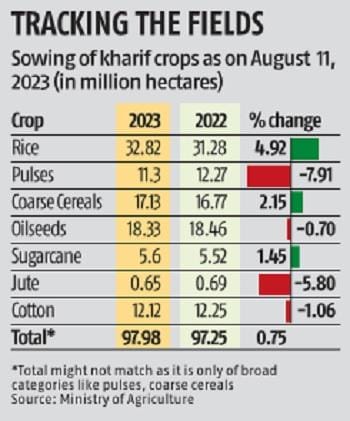
Sowing of kharif crops is over in almost 90 per cent of the normal area during the week of August 11, with acreage of rice being higher by almost 4.92 per cent compared to the same period last year.
On the other hand, arhar and urad were down by 5.41 per cent and 13.49 per cent, respectively, as compared to the same period in 2022. Paddy sowing is down so far in Andhra Pradesh, Assam, and Odisha.
The normal area is the average area covered under a particular crop in the previous five years.
Usually, the sowing of Kharif crops starts nearing its end in mid-August, but this year, several farmers said the period of planting may get extended. This is because it started late due to the delayed onset of the southwest monsoon in several parts of the country.
In the case of arhar, the acreage of which is down compared to last year, almost 87 per cent of the normal area has been covered till August 11.
Similarly, in the case of urad, too, acreage of which is down, data showed that till August 11, almost 75 per cent of the normal area had been covered.
In the case of rice, which is the biggest food grain grown during the kharif season, and which has been under the spotlight for the last few months due to the ban on exports as a consequence of the increase in retail price, data showed that till this week, around 32.82 million hectares have been covered under the crop.
So far, data showed that around 82.25 per cent of the normal area under paddy has been covered till August 11.
Meanwhile, the southwest monsoon has entered into a break phase after a vigorous run in July. As a consequence, the rainfall deficit between August 1 and 11 has been almost 29 per cent.
Southern Peninsular India leads with a 72 per cent shortfall, and North-West India is at a 38 per cent deficit, according to meteorologists.
Onion Buffer: The government on Friday said it would release onion from its buffer stock — of almost 0.3 million tonnes — in the targeted regions with immediate effect. This ensures that prices remain under check until the new crop arrives from October onwards.
The government is exploring multiple options for the disposal of onion: e-auction, e-commerce, and through states at discounted rates. It said it will be via retail outlets of the respective consumer cooperatives and corporations.








